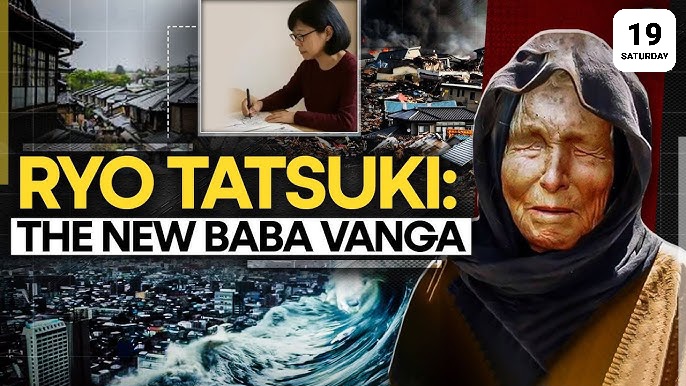
Ryo Tatsuki
Japanese illustrator Ryo Tatsuki, dubbed by the media as the «Japanese Baba Vanga,» went viral in July 2025 for an alleged apocalyptic prophecy predicting a devastating natural disaster for Japan on July 5. This prediction, originally published in a 1999 manga, captured international attention and sparked mass panic, tourist cancellations, and a profound debate about prophecies, sensationalism, and the culture of fear.
Origin of Prophecy
In 1999, artist Ryo Tatsuki published a manga titled «The Future I Saw,» illustrating a series of premonitory dreams she had supposedly had. In this work, one of the predictions pointed precisely to July 5, 2025, signaling a major natural disaster in Japan. What drew attention was the specificity of the date and its presentation as an event of catastrophic scale, including an earthquake and tsunami with devastating consequences. Tatsuki’s work did not have a great impact upon its release, but over the years, some of her predictions gained notoriety for their supposed accuracy: among them, the attacks of September 11, 2001, the Great Japanese Earthquake of 2011, and the COVID-19 pandemic. These coincidences fueled her image as a prophetess and revitalized her work on social media.
Viralization on Social Networks
In early 2025, the July 5th prophecy began to spread widely on platforms like TikTok, Twitter, and YouTube. Hundreds of videos, with millions of views, spoke of the «forgotten prophecy» that predicted the destruction of Tokyo or the collapse of Japan. Some users even developed conspiracy theories, linking Tatsuki’s dreams to Nostradamus’s predictions or abnormal solar movements. The hashtag #July5Prediction reached millions of mentions and became a global trend. International media coverage amplified the phenomenon, and news networks in Asia and Latin America presented it as a warning that «many were taking seriously.»
Impact on Japanese Tourism
One of the most immediate side effects was the collapse of tourism to Japan from countries such as China, Thailand, Hong Kong, and South Korea. According to the Japan Association of Travel Agencies, cancellations exceeded 50% in some areas, especially Tokyo and Osaka. At Narita and Kansai International Airports, a sharp drop in international traffic was reported between July 3 and 5. Local tourism companies reported multimillion-dollar losses. The hotel sector was affected by the suspension of bookings, and several travelers shared their cancellations on social media, justifying their fear of the «prophecy.»
Response from the Authorities
As panic grew, the Japan Meteorological Agency (JMA) and the Ministry of the Interior issued official statements stating that there was no scientific evidence of an imminent disaster. The public was urged not to spread misinformation and to consult only official sources. The Japanese Prime Minister issued a statement during a press conference on July 3, urging calm: «Japan is prepared for any eventuality, but there is no alert for July 5. We invite our visitors and citizens to continue with their plans as normal.»
July 5th A Day Without Disasters
When July 5th arrived, the country woke up under strict media and social media surveillance. Despite the collective fear, no major disaster was recorded that day. Minor tremors occurred in the Kyushu region and northern Honshu, but without material damage or casualties. This sparked a second viral cycle: videos and memes ridiculing the prophecy multiplied, and many users took the opportunity to denounce the mass hysteria generated by social media.
Criticism of digital sensationalism
Various analysts and communications experts criticized the role of digital platforms in amplifying fear. The University of Tokyo published a report indicating that 78% of Japanese people under 30 learned about the prophecy through TikTok or Instagram, without verifying its veracity. A debate arose about the responsibility of influencers and alternative media outlets for spreading apocalyptic predictions without a scientific basis. Likewise, several academic figures requested that platforms such as YouTube and Twitter label this type of content as «sensationalist» or «unverified.»
Ryo Tatsuki: myth or fraud
Following the media hype, renewed interest in Ryo Tatsuki emerged. Some media outlets attempted to reach her for interviews, but the artist has not commented since 2006. This fueled the mystery surrounding her identity and prompted new conspiracy theories. While some consider her a misunderstood visionary, others accuse her of fraud or of having created a simple work of fiction that was misinterpreted. The truth is that her work has been republished in new editions that have sold out in Japanese bookstores and on platforms like Amazon Japan.
Final reflection
The case of the «Japanese Baba Vanga» is a striking example of how collective fear can go viral in the digital age. Despite the absence of a disaster, the economic, social, and emotional impact was real. The episode provides a lesson about the importance of media education, critical thinking, and verifying information before sharing it. In an increasingly interconnected world exposed to information overload, these types of cases could recur if more effective digital literacy measures are not implemented. The figure of Ryo Tatsuki, whether myth or reality, will continue to be the subject of debate as long as society remains fascinated with prophecies, the occult, and destiny.
The Japanese Baba Vanga: Prophecy of a mega-disaster in Japan on July 5, 2025